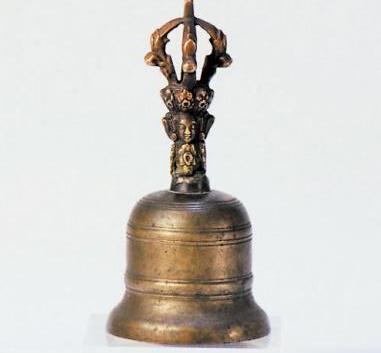jingangling overview
 The Jingang bell (pinyin: Jīngāng líng) is a musical instrument of the Tibetan, Mongolian, Naxi, Han and other ethnic groups. Tibetan called Zhibu, Ziba. The Han people call it Fa bell and Tibetan bell. With a long history, it was originally a Buddhist tantric instrument, which was introduced to my country from India. It is popular in Buddhist monasteries all over the country, especially in Tibet, Inner Mongolia, Qinghai, Gansu, Sichuan, Yunnan and other provinces. The body of the bell is shaped like a bell, with a round lower mouth. The top and body of the bell are decorated with intricate patterns. Inside the body of the bell is a copper clapper, which is used for lama chanting and Buddhist music. According to experts, the vajra bell is an instrument used in the practice of the Dharma.
The Jingang bell (pinyin: Jīngāng líng) is a musical instrument of the Tibetan, Mongolian, Naxi, Han and other ethnic groups. Tibetan called Zhibu, Ziba. The Han people call it Fa bell and Tibetan bell. With a long history, it was originally a Buddhist tantric instrument, which was introduced to my country from India. It is popular in Buddhist monasteries all over the country, especially in Tibet, Inner Mongolia, Qinghai, Gansu, Sichuan, Yunnan and other provinces. The body of the bell is shaped like a bell, with a round lower mouth. The top and body of the bell are decorated with intricate patterns. Inside the body of the bell is a copper clapper, which is used for lama chanting and Buddhist music. According to experts, the vajra bell is an instrument used in the practice of the Dharma.The diamond bell is composed of three parts: the bell body, the bell handle, and the bell tongue. The body of the bell is shaped like a bell, cast in bronze, with a round mouth, flush edges, and a delicate pattern on the top and around the body. The tongue of the bell is made of copper or iron, in the shape of a rod and hangs on the top of the inner cavity of the bell body. The handle of the bell is made of copper or silver, longer than the body of the bell, and is decorated with elaborate decorations. The head of Manjushri is mostly cast in the middle, and the top is mostly hollow. The body and handle of the diamond bell are mostly cast separately, and then welded or riveted with copper, tin. Sizes vary, the larger is 25.2 cm high, the handle is 16.2 cm long, and the bell mouth diameter is 10.8 cm; the smaller is 14.8 cm high, 8.8 cm long, and 7.4 cm in diameter.
The handle of the vajra bell is one end of a vajra pestle, so the vajra bell can also be regarded as a transformation of the vajra pestle, that is, changing one end of the vajra pestle into a bell shape.
The diamond bell is one of the esoteric instruments. Another golden bell. Among them, those used in Tibetan esotericism are also called Tibetan bells. It is the bell that shakes to urge all beings to be diligent and to awaken the awakening of Buddhas and Bodhisattvas. That is, in the practice of the Dharma, in order to wake up, persuade the honored ones, and make them rejoice, they shake it.
The instruments used in the practice of the Dharma represent the skill, convenience, and great compassion of the Buddha. It also means "awakened one", and the bell can wake sentient beings from their ignorant sleep. Sentient beings are endlessly reincarnated due to ignorance and attachment, and the three poisons of greed, hatred, ignorance and ignorance arise from this, so use bells to alert them.
- Pinyin:Jīngāng líng
- category:Shaking Body Musical Instrument
- Tibetan language:Stop cloth, Ziba
- popular area:Tibet, Inner Mongolia, Qinghai, Gansu, Sichuan, Yunnan and other provinces
overview of other similar instruments
- sanyanxiao overview
- Daguangxian overview
- Leiqin overview
- hahao overview
- yandundagu overview
- Han Xiaozheng overview
- Fang Xiang overview
- guanzi overview
- zhuqin (Dao Qin) overview
- zhuiqin overview
- bangzi overview
- three-stringed piano overview
- Gehu overview
- xiao overview
- xiaokonghou overview
- Konghou overview
- Sheng overview
- suona overview
- hulusi overview
- gushao overview
 渝公网安备 50010702504639号
渝公网安备 50010702504639号